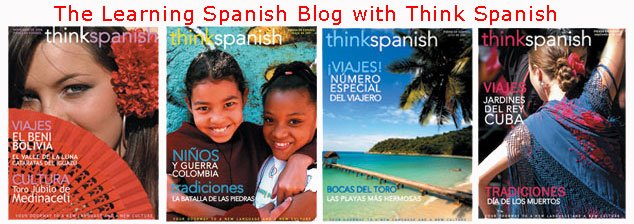Monday, August 25, 2008
Spanish Grammar Quick Tip
eg. Talk to Her; And Your Mother Too
However, in Spanish, titles are only capitalized at the beginning of the title. The titles of the Think Spanish Magazine articles give some great examples of this, but others are:
eg. Habla con ella; Y tu mamá también
Stay tuned for more grammar quick tips, lessons, and quizzes. Place the Think Spanish Blog on your RSS Feed so that you don't miss out.
Thursday, August 21, 2008
Diarios de motocicleta
Tuesday, August 19, 2008
Mini Lesson on Direct and Indirect Objects
An indirect object is the person to or from whom the action is done. It answers the question “To whom” or “For whom” (Whom does she give gifts to? She gives gifts to you, him, and her.)
The direct object pronouns:
me, te, nos, lo, la, los, and las
depending on the gender and number of the object under consideration.
Indirect objects require the use of the same pronouns as with direct objects but also include “le” and “les,” which are used for the third person. Unlike English, both direct and indirect object pronouns are placed before the verb. They can also be connected to the end of the infinitive, as in “puedo leerlo,” but this is a little less common. The pronouns are also placed at the end of commands, as in “¡Dámelo!”
In the phrase, “Lo miro,” lo is the direct object. What do you look at?: I look at it.
Mi hermana me dan regalos. “Me” is the indirect object. Whom does she give gifts to?: To me.
Test your direct and indirect object skills in our quiz!
Wednesday, August 13, 2008
Costa Rica - August's Free Article!
Have you been to
 If you’ve been to
If you’ve been to Monday, August 4, 2008
Braser Product Review -- Go for the "Spanish Whiz"
I spent more time of the more accelerated "Spanish Whiz" program, and it really helped increase my vocabulary and challenged my verb use. You can choose among three levels with increasing difficulty. The first level is plenty challenging but still not intimidating, and the third level is great for advanced learners wanting to perfect their grammar.
Spanish Whiz tests your ability to conjugate while increasing your word recognition. The program uses the same words in different exercises so you continue to gain exposure to them. There is audio along with each phrase and word, so that you can hear the correct pronunciation and repeat it out loud.
This way, while you move through the exercises, you’re utilizing and strengthening various skills at the same time—building a verb vocabulary base while practicing conjugating…while perfect your grammar…while being introduced to new nouns…while listening to the pronunciation…while reading the phrases. The program even has games and jokes, making for an even more interactive experience. You can look words up in the dictionary and also make a personalized dictionary for words you’re trying to memorize.
Think Spanish! Magazine highly recommends Braser!
Have you tried Braser? What did you think? Please leave your comments below.
